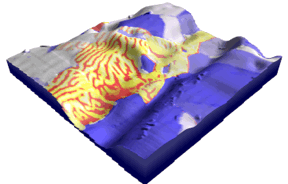Home > Press > Oxford Instruments Asylum Research Announces New “Relate” Software for Correlative Imaging with Atomic Force Microscopy and Electron Microscopy
 |
| Composite 3D image of a duplex steel sample prepared in Relate, comprising AFM topography and magnetic force microscopy data along with EBSD phase map (blue and red) and grain boundaries (greyscale). |
Abstract:
Oxford Instruments Asylum Research is pleased to announce the release of the new “Relate” software package for correlative imaging with Asylum Research AFMs, electron microscopes, and Oxford Instruments NanoAnalysis EDS and EBSD detectors. The Relate software makes it simple to correlate, visualize, and analyze the multitude of image data types generated by these techniques. Correlative imaging enables scientists and engineers to realise the combined insights provided by these techniques for applications including semiconductors, metallurgy, and energy storage and generation materials.
Oxford Instruments Asylum Research Announces New “Relate” Software for Correlative Imaging with Atomic Force Microscopy and Electron Microscopy
Santa Barbara, CA | Posted on June 12th, 2020“It is obvious that the elemental composition information from EDS and the crystallographic data from EBSD can complement the nanoscale structural, electrical, mechanical, and functional information that is generated by Asylum Research AFMs,” explained Dr. Roger Proksch, Group Technology Officer for Oxford Instruments. “But it has been difficult to take advantage of these synergies because the data is collected in slightly different regions of the sample and in different data formats. The Relate software solves those problems, making it far easier to correlate and analyze these complementary datasets.”
The Relate software works by importing data files in the native formats used by Asylum Research AFMs and Oxford Instruments NanoAnalysis EDS and EBSD detectors. Though one can closely match the area inspected by the different techniques, there will always be some mismatch in the position, scale, and rotation of these datasets. Relate allows the user to readily correlate data from the same region of interest and prepare composite 2D and 3D images. Most importantly, unlike simplistic image overlays, the underlying data structure of each layer is maintained by Relate. This enables not just visualisation, but true quantitative analysis of the combined datasets.
####
For more information, please click here
Contacts:
Ben Ohler, Director of Marketing, 805-696-6466
Copyright © Oxford Instruments Asylum Research
If you have a comment, please Contact us.Issuers of news releases, not 7th Wave, Inc. or Nanotechnology Now, are solely responsible for the accuracy of the content.
| Related News Press |
News and information
![]() Researchers develop molecular qubits that communicate at telecom frequencies October 3rd, 2025
Researchers develop molecular qubits that communicate at telecom frequencies October 3rd, 2025
![]() Next-generation quantum communication October 3rd, 2025
Next-generation quantum communication October 3rd, 2025
![]() "Nanoreactor" cage uses visible light for catalytic and ultra-selective cross-cycloadditions October 3rd, 2025
"Nanoreactor" cage uses visible light for catalytic and ultra-selective cross-cycloadditions October 3rd, 2025
Imaging
![]() ICFO researchers overcome long-standing bottleneck in single photon detection with twisted 2D materials August 8th, 2025
ICFO researchers overcome long-standing bottleneck in single photon detection with twisted 2D materials August 8th, 2025
![]() Simple algorithm paired with standard imaging tool could predict failure in lithium metal batteries August 8th, 2025
Simple algorithm paired with standard imaging tool could predict failure in lithium metal batteries August 8th, 2025
![]() First real-time observation of two-dimensional melting process: Researchers at Mainz University unveil new insights into magnetic vortex structures August 8th, 2025
First real-time observation of two-dimensional melting process: Researchers at Mainz University unveil new insights into magnetic vortex structures August 8th, 2025
![]() New imaging approach transforms study of bacterial biofilms August 8th, 2025
New imaging approach transforms study of bacterial biofilms August 8th, 2025
Software
![]() Visualizing nanoscale structures in real time: Open-source software enables researchers to see materials in 3D while they're still on the electron microscope August 19th, 2022
Visualizing nanoscale structures in real time: Open-source software enables researchers to see materials in 3D while they're still on the electron microscope August 19th, 2022
![]() Luisier wins SNSF Advanced Grant to develop simulation tools for nanoscale devices July 8th, 2022
Luisier wins SNSF Advanced Grant to develop simulation tools for nanoscale devices July 8th, 2022
![]() Oxford Instruments’ Atomfab® system is production-qualified at a market-leading GaN power electronics device manufacturer December 17th, 2021
Oxford Instruments’ Atomfab® system is production-qualified at a market-leading GaN power electronics device manufacturer December 17th, 2021
Announcements
![]() Rice membrane extracts lithium from brines with greater speed, less waste October 3rd, 2025
Rice membrane extracts lithium from brines with greater speed, less waste October 3rd, 2025
![]() Researchers develop molecular qubits that communicate at telecom frequencies October 3rd, 2025
Researchers develop molecular qubits that communicate at telecom frequencies October 3rd, 2025
![]() Next-generation quantum communication October 3rd, 2025
Next-generation quantum communication October 3rd, 2025
![]() "Nanoreactor" cage uses visible light for catalytic and ultra-selective cross-cycloadditions October 3rd, 2025
"Nanoreactor" cage uses visible light for catalytic and ultra-selective cross-cycloadditions October 3rd, 2025
Tools
![]() Japan launches fully domestically produced quantum computer: Expo visitors to experience quantum computing firsthand August 8th, 2025
Japan launches fully domestically produced quantum computer: Expo visitors to experience quantum computing firsthand August 8th, 2025
![]() Rice researchers harness gravity to create low-cost device for rapid cell analysis February 28th, 2025
Rice researchers harness gravity to create low-cost device for rapid cell analysis February 28th, 2025
|
|
||
|
|
||
| The latest news from around the world, FREE | ||
|
|
||
|
|
||
| Premium Products | ||
|
|
||
|
Only the news you want to read!
Learn More |
||
|
|
||
|
Full-service, expert consulting
Learn More |
||
|
|
||








